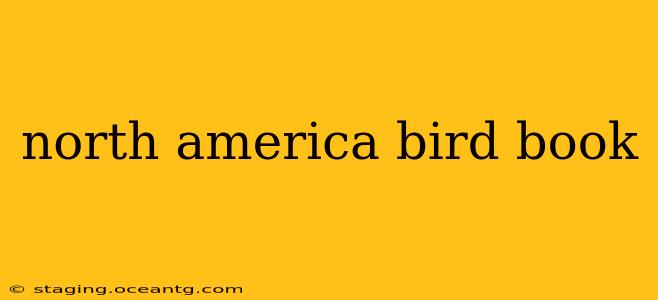Identifying birds can be a rewarding hobby, connecting you with the natural world and its incredible biodiversity. But navigating the vast selection of North American bird books can feel overwhelming. This guide cuts through the noise, helping you choose the perfect field guide for your experience level, birdwatching style, and specific needs. We'll explore various options, from beginner-friendly guides to expert-level resources, addressing common questions bird enthusiasts have.
What are the Best Bird Books for Beginners?
For those just starting their birding journey, choosing a user-friendly guide is crucial. Look for books with clear photographs or illustrations, concise descriptions, and perhaps even range maps that help you narrow down possibilities based on location. Many excellent introductory guides exist, featuring beautiful imagery and easy-to-understand language. Don't get bogged down in overly technical details; focus on learning to identify common species first.
What's the Difference Between a Field Guide and a Bird Identification Book?
While the terms are often used interchangeably, there's a subtle difference. Field guides are designed for portability and quick identification in the field. They prioritize visual aids like photographs or illustrations, along with concise descriptions of key identification features. Bird identification books, on the other hand, often delve deeper into the natural history of birds, including behavior, habitat, songs, and distribution. They might include more detailed descriptions and even incorporate range maps showing where specific species can be found throughout their habitat. The best choice depends on your needs and how you plan to use the book.
What Bird Books Feature Detailed Illustrations?
Many bird enthusiasts prefer illustrations over photographs for several reasons. Illustrations can highlight key identifying features more clearly, and they’re less susceptible to variations in lighting and bird posture that can affect photographic identification. Several excellent guides are renowned for their high-quality illustrations, offering detailed depictions of plumage, size, and shape – features critical for accurate species identification.
Which Bird Books are Best for Experienced Birders?
Experienced birders often seek guides that go beyond basic identification. Advanced guides might include more in-depth information on subspecies, variations in plumage, and detailed descriptions of vocalizations. They may also include information on bird behavior, ecology, and conservation status. These books often feature more detailed maps and charts, providing a comprehensive understanding of North American avian species. These advanced resources serve as valuable tools for serious birders looking to deepen their knowledge.
Are there any Regional Bird Guides for North America?
Yes! North America's diverse geography and avian populations mean that regional guides can be extremely helpful. Regional guides often focus on the bird species most likely found in a specific area, making identification quicker and more efficient. This targeted approach eliminates the need to sift through numerous entries for species that might not even be present in your location.
What are some good resources to help identify bird songs?
While many field guides include descriptions of bird songs, dedicated resources focusing solely on bird vocalizations can be incredibly beneficial. There are numerous apps and online databases that provide audio recordings of bird songs, allowing you to learn to distinguish between different species by ear. This multi-sensory approach significantly enhances your bird identification skills. Combining visual identification from a field guide with auditory identification using audio resources provides a robust and comprehensive approach.
What is the best book for identifying birds in my specific region?
To recommend the ideal book for your region, I need more information about your location. Please specify the state or province where you'll primarily be birdwatching. Knowing your specific geographic area allows for a more precise recommendation, ensuring that the selected field guide contains the relevant bird species for your area.
This guide provides a starting point for your search. Remember to consider your skill level, preferred visual style (photographs vs. illustrations), and your birding goals when making your decision. Happy birding!
